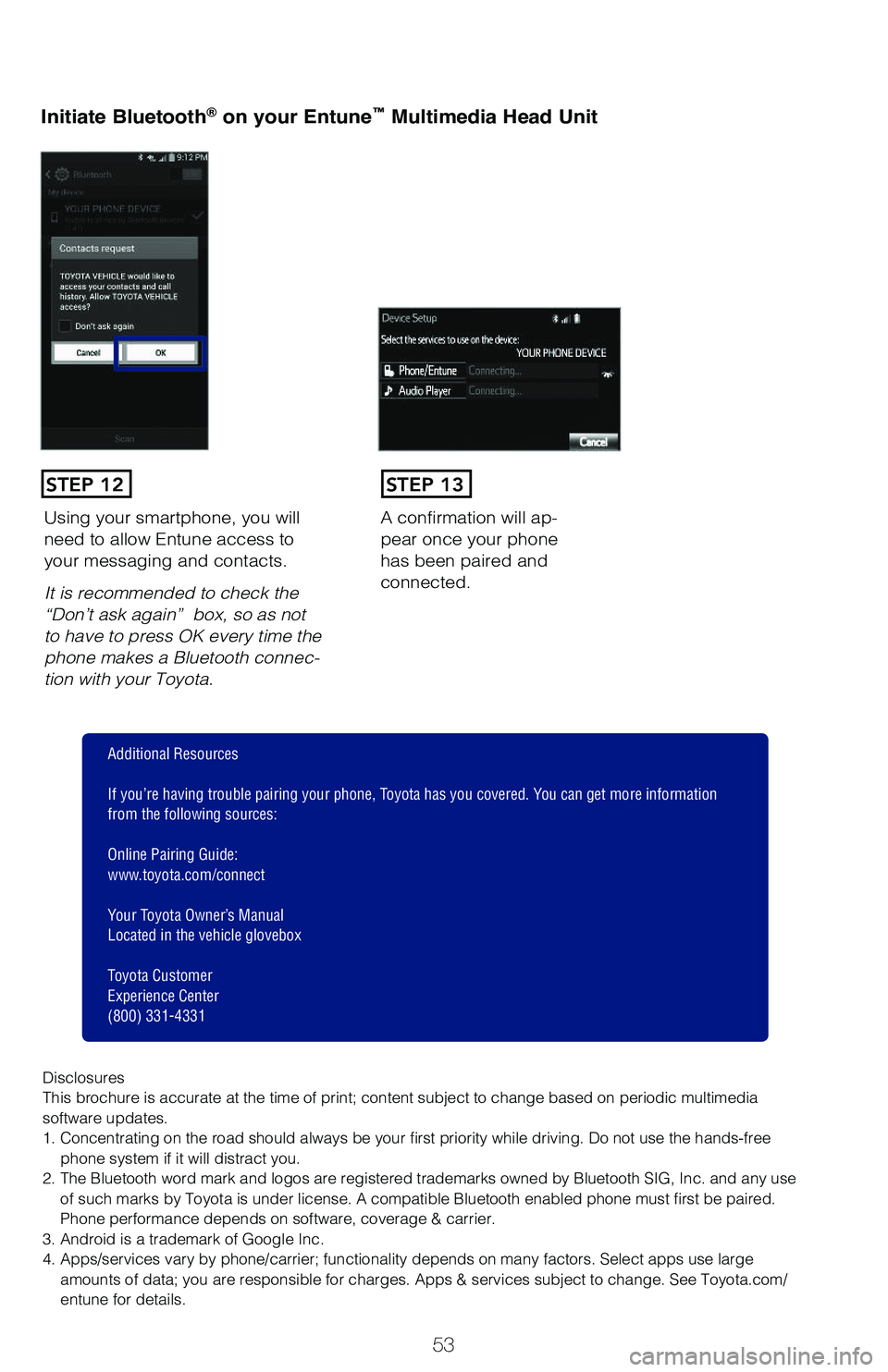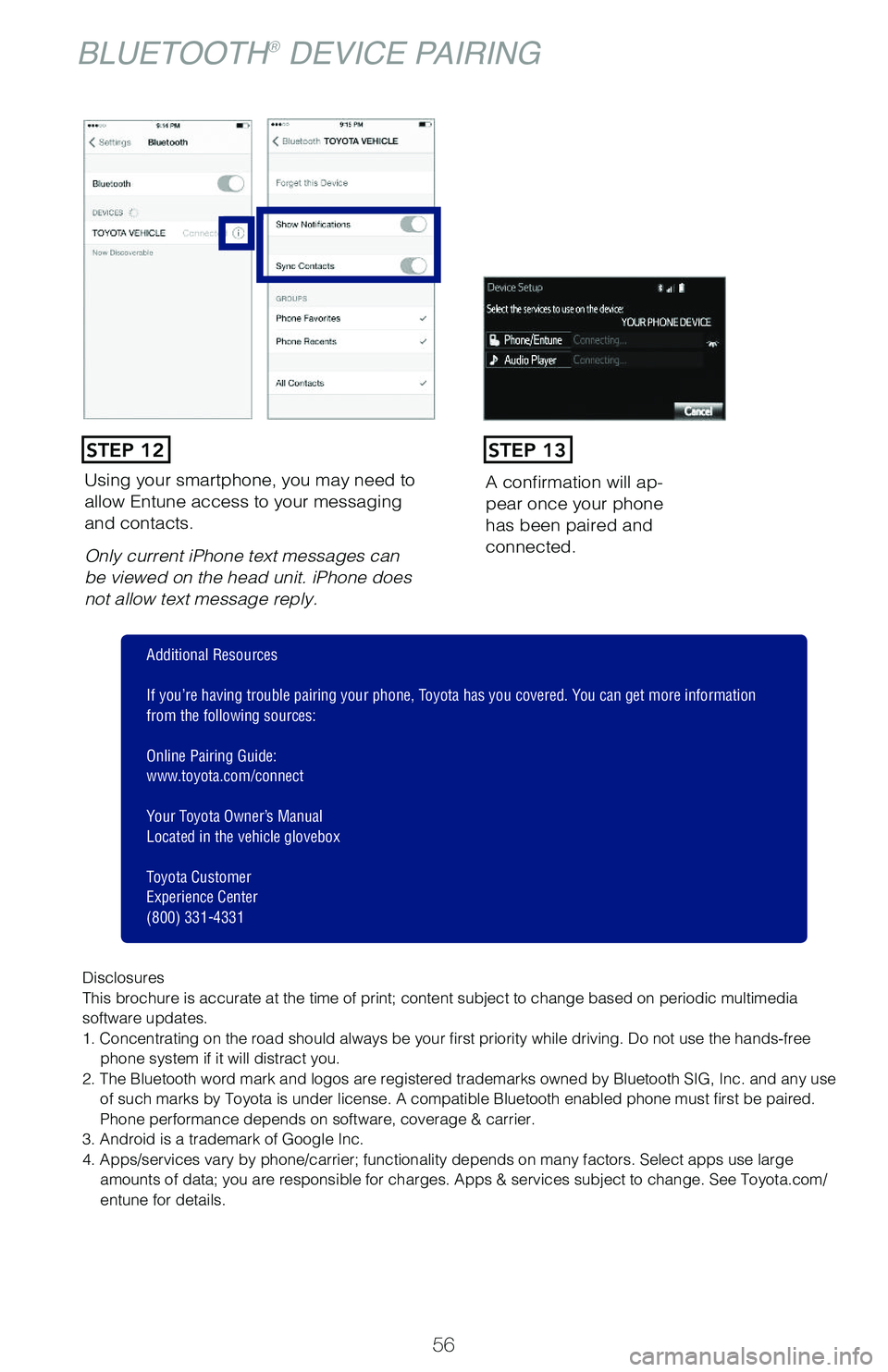2019 TOYOTA PRIUS ESP
[x] Cancel search: ESPPage 12 of 60

10
TIPS FOR IMPROVED FUEL ECONOMY
STARTING YOUR VEHICLE
NOTE: Fuel consumption and energy information of the Hybrid System are
shown on the Entune™ Audio system screen or the navigation system.
The Hybrid Synergy Drive System utilizes a computer-controlled gasoline engine
and electric motor to provide the most efficient combination of power for the vehicle.
To conserve energy, when the brakes are applied the braking force generates
electricity which is then sent to the traction battery. In addition, the engine shuts off
when the vehicle is stopped. The benefits are better fuel economy, reduced vehicle
emissions and improved performance.
1. Ensure tire pressures are maintained at levels specified in the Owner’s Manual.
2. When possible, link trips to reduce engine cold starts.
3. Avoid driving at speeds that are higher than necessary, especially on the highway.
4. When possible, avoid sudden stops to maximize regenerative braking energy.
5. Minimize use of the air conditioning.
Hybrid Synergy Drive System
Auto lock/unlock
FEATURES & OPERATIONS
(1) Depress the brake pedal, and “”
will be displayed on the Multi-Information
Display.
(2) Press the “POWER” switch briefly and
firmly.
(3) The “READY” light will blink. After
a few seconds, when the light remains
steady and a beep sounds, you may
begin driving.
Automatic door locks can be programmed to operate in different modes, or turned
OFF.
Shift position linked door locking/unlocking function
-Doors lock when shifting from Park.
-Doors unlock when shifting into Park.
Speed linked door locking function
-Doors lock when the vehicle speed goes above approximately 12 mph.
Driver’s door linked door unlocking function
-Doors unlock when the driver’s door is opened within 45 seconds after turning the
“POWER” switch to OFF.
Refer to the Owner’s Manual for more details.
116674_MY19_Prius_QRG_V3_ML_1126_TEXT_R1.indd 1011/26/18 10:52 PM
Page 13 of 60

11
OVERVIEW
FEATURES & OPERATIONS
TOYOTA SAFETY SENSE
SAFETY & EMERGENCY FEATURES
* The engine brake is the equivalent of downshifting. Shift to “B” when engine
braking is desired (i.e. downhill driving, coasting to a stop, etc.).
Reverse
Park button
Neutral
Drive
Engine brake*
Hybrid transmission
Driving mode select switch
EV Drive Mode ON/OFF switch EV-Drive Mode allows the electric motor (traction
motor), powered by the hybrid battery (traction battery), to be used to drive the
vehicle under certain driving conditions.
Refer to the Owner’s Manual for more details.
Normal - Suitable for
normal driving.
Power mode - Use when
a higher level of response
is desired, such as when
driving in mountainous
regions.
ECO drive mode -
Helps achieve lower fuel
consumption during trips
that involve frequent
accelerating and braking.Refer to the Owner’s Manual for more details.
EV drive mode switch
116674_MY19_Prius_QRG_V3_ML_1126_TEXT_R1.indd 1111/26/18 10:52 PM
Page 36 of 60

34
CHANGING PCS ALERT TIMING
TOYOTA SAFETY SENSE™
Far
Middle(default)
Near
(1) Press “” switches and select from the Multi-Information Display (MID).
(2) Press “” switches and select from the MID and then press “”. The
setting screen is displayed.
(3) Press “” each time to change the setting. Each time it is pressed, the
response to the PCS alert timing changes as shown above. You can press “” to
go back to the menu.
Note: PCS is enabled each time the engine switch is turned to Ignition On. The system can be disabled/enabled and the alert timing of the system can be changed. (Alert timing only, brake operation remains the same).
Monocular camera sensor
Millimeterwave radar
As part of the Pre-Collision System, this function is also designed to first provide an alert and then automatic braking if needed.
Under certain conditions, the PCS system included with the TSS-P package may also help to detect a pedestrian in front of your vehicle using the in-vehicle camera and front-grill mounted millimeter wave radar. The in-vehicle camera of PCS detects a potential pedestrian based on size, profile, and motion of the detected pedestrian. However, a pedestrian may not be detected depending on the conditions, including the surrounding brightness and the motion, posture, size, and angle of the potential detected pedestrian, preventing the system from operating or engaging.
PCS PEDESTRIAN DETECTION
Refer to the Toyota Owner’s Manual for additional limitations and information.
116674_MY19_Prius_QRG_V3_ML_1126_TEXT_R1.indd 3411/26/18 10:52 PM
Page 42 of 60

40
ADJUSTING DISTANCE
To change the vehicle-to-vehicle distance
Push the “” button to cycle
through the settings, which will
change progressively.
This mode employs a radar sensor to detect the presence of a preceding vehicle
up to approximately 328 ft (100 m) ahead, determines the current vehicle-to-vehicle
following distance and operates to maintain a preset following distance from the
vehicle ahead. These distances vary based on vehicle speed.
Preceding vehicle mark
LONG(default setting)MIDDLESHORT
(1) (2) (3)
(1) Constant speed cruising when there are no vehicles ahead
The vehicle travels at the speed set by the driver. The desired vehicle-to-
vehicle distance can also be set by operating the vehicle-to-vehicle distance
control.
(2) Deceleration cruising and follow-up cruising when a preceding vehicle
driving slower than the set speed appears
When a vehicle is detected running ahead of you, the system automatically
decelerates your vehicle. When a greater reduction in vehicle speed is
necessary, the system applies the brakes (the brake lights will come on at this
time). The system will respond to changes in the speed of the vehicle ahead
in order to maintain the vehicle-to-vehicle distance set by the driver. A warning
tone warns you when the system cannot decelerate sufficiently to prevent your
vehicle from closing in on the vehicle ahead.
Note: Vehicle-to-vehicle distance will close in when traveling on long downhill
slopes.
TOYOTA SAFETY SENSE™
116674_MY19_Prius_QRG_V3_ML_1126_TEXT_R1.indd 4011/26/18 10:52 PM
Page 46 of 60

44
Rear door child safety locks
SAFETY & EMERGENCY FEATURES
Safety Connect (if equipped)
Safety Connect is a subscription-based telematics service that uses Global
Positioning System (GPS) data and embedded cellular technology to provide safety
and security features to subscribers. Safety Connect is supported by Toyota’s
designated response center, which operates 24 hours per day, 7 days per week.
Services for subscribers include:
• Automatic collision notification
• Stolen vehicle location
• Emergency assistance (“SOS” button)
• Enhanced roadside assistance
Microphone
LED light indicators
“SOS” button
Contact your dealer for more information about Safety Connect.
For details, refer to the “Owner’s Manual” or visit www.Toyota.com/safety-connect.
Moving the lever downward will allow the door to be opened only from the outside.
Rear door
Lock
Unlock
116674_MY19_Prius_QRG_V3_ML_1126_TEXT_R1.indd 4411/26/18 10:52 PM
Page 50 of 60

48
SAFETY & EMERGENCY FEATURES
SMART STOP TECHNOLOGY (SST)
Star Safety System™
Smart Stop Technology automatically reduces engine power when the accelerator
and brake pedals are pressed simultaneously under certain conditions.
SST engages when the accelerator is depressed first and the brakes are applied
firmly for longer than one-half second at speeds greater than five miles per hour.
SST doesn’t engage if the brake pedal is depressed before the accelerator pedal,
allowing vehicles to start on a steep hill and safely accelerate without rolling
backward.
Refer to the Brake Override System section in the Owner’s Manual for more
information on Smart Stop Technology.
ENHANCED VEHICLE STABILITY CONTROL (VSC)
Enhanced Vehicle Stability Control provides cooperative control of the ABS, TRAC,
VSC and EPS.
Enhanced VSC helps to maintain directional stability when loss of traction occurs
during a turn.
ANTI-LOCK BRAKE SYSTEM (ABS)
Toyota’s ABS sensors detect which wheels are locking up and limits wheel lockup
by “pulsing” each wheel’s brakes independently. Pulsing releases brake pressure
repeatedly for fractions of a second. This helps the tires attain the traction that
current road conditions will allow, helping you to stay in directional control.
BRAKE ASSIST (BA)
Brake Assist is designed to detect sudden or “panic” braking, and then add braking
pressure to help decrease the vehicle’s stopping distance. When there’s only a split
second to react, Brake Assist can add additional brake pressure more quickly than
just the driver alone can.
ELECTRONIC BRAKE FORCE DISTRIBUTION (EBD)
Toyota’s ABS technology has Electronic Brake-force Distribution (EBD) to help
maintain control and balance when braking. EBD responds to sudden stops by
redistributing brake force to enhance the braking effectiveness of all four wheels.
Your vehicle comes standard with the Star Safety SystemTM, which combines Anti-
lock Braking System (ABS), Brake Assist (BA), Electronic Brake-force Distribution
(EBD), Smart Stop Technology (SST), Traction Control (TRAC) and Vehicle Stability
Control (VSC).
Refer to the Owner’s Manual for more details and important information on limitations
to these systems.
116674_MY19_Prius_QRG_V3_ML_1126_TEXT_R1.indd 4811/26/18 10:52 PM
Page 55 of 60

53
Initiate Bluetooth® on your Entune™ Multimedia Head Unit
A confirmation will ap-pear once your phone has been paired and connected.
Using your smartphone, you will need to allow Entune access to your messaging and contacts.
It is recommended to check the “Don’t ask again” box, so as not to have to press OK every time the phone makes a Bluetooth connec-tion with your Toyota.
STEP 12STEP 13
Additional Resources
If you’re having trouble pairing your phone, Toyota has you covered. You can get more informationfrom the following sources:
Online Pairing Guide:www.toyota.com/connect
Your Toyota Owner’s ManualLocated in the vehicle glovebox
Toyota Customer Experience Center(800) 331-4331
DisclosuresThis brochure is accurate at the time of print; content subject to change based on periodic multimedia software updates.1. Concentrating on the road should always be your first priority while driving. Do not use the hands-free phone system if it will distract you.2. The Bluetooth word mark and logos are registered trademarks owned by Bluetooth SIG, Inc. and any use of such marks by Toyota is under license. A compatible Bluetooth enabled phone must first be paired. Phone performance depends on software, coverage & carrier.3. Android is a trademark of Google Inc.4. Apps/services vary by phone/carrier; functionality depends on many factors. Select apps use large amounts of data; you are responsible for charges. Apps & services subject to change. See Toyota.com/entune for details.
116674_MY19_Prius_QRG_V3_ML_1126_TEXT_R1.indd 5311/26/18 10:52 PM
Page 58 of 60

56
Using your smartphone, you may need to allow Entune access to your messaging and contacts.
Only current iPhone text messages can be viewed on the head unit. iPhone does not allow text message reply.
A confirmation will ap-pear once your phone has been paired and connected.
STEP 12STEP 13
BLUETOOTH® DEVICE PAIRING
DisclosuresThis brochure is accurate at the time of print; content subject to change based on periodic multimedia software updates.1. Concentrating on the road should always be your first priority while driving. Do not use the hands-free phone system if it will distract you.2. The Bluetooth word mark and logos are registered trademarks owned by Bluetooth SIG, Inc. and any use of such marks by Toyota is under license. A compatible Bluetooth enabled phone must first be paired. Phone performance depends on software, coverage & carrier.3. Android is a trademark of Google Inc.4. Apps/services vary by phone/carrier; functionality depends on many factors. Select apps use large amounts of data; you are responsible for charges. Apps & services subject to change. See Toyota.com/entune for details.
Additional Resources
If you’re having trouble pairing your phone, Toyota has you covered. You can get more informationfrom the following sources:
Online Pairing Guide:www.toyota.com/connect
Your Toyota Owner’s ManualLocated in the vehicle glovebox
Toyota Customer Experience Center(800) 331-4331
116674_MY19_Prius_QRG_V3_ML_1126_TEXT_R1.indd 5611/26/18 10:52 PM